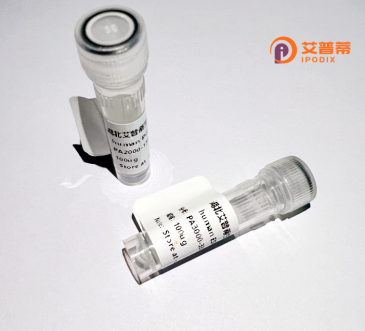
| 纯度 | >90%SDS-PAGE. |
| 种属 | Human |
| 靶点 | PAQR5 |
| Uniprot No | Q9NXK6 |
| 内毒素 | < 0.01EU/μg |
| 表达宿主 | E.coli |
| 表达区间 | 1-330 aa |
| 活性数据 | MLSLKLPRLFSIDQIPQVFHEQGILFGYRHPQSSATACILSLFQMTNETLNIWTHLLPFW FFAWRFVTALYMTDIKNDSYSWPMLVYMCTSCVYPLVSSCAHTFSSMSKNARHICYFLDY GAVNLFSLGSAIAYSAYTFPDALMCTTFHDYYVALAVLNTILSTGLSCYSRFLEIQKPRL CKVIRVLAFAYPYTWDSLPIFYRLFLFPGESAQNEATSYHQKHMIMTLLASFLYSAHLPE RLAPGRFDYIGHSHQLFHVCVILATHMQMEAILLDKTLRKEWLLATSKPFSFSQIAGAIL LCIIFSLSNIIYFSAALYRIPKPELHKKET |
| 分子量 | 38.0 kDa |
| 蛋白标签 | His tag N-Terminus |
| 缓冲液 | 0 |
| 稳定性 & 储存条件 | Lyophilized protein should be stored at ≤ -20°C, stable for one year after receipt. Reconstituted protein solution can be stored at 2-8°C for 2-7 days. Aliquots of reconstituted samples are stable at ≤ -20°C for 3 months. |
| 复溶 | Always centrifuge tubes before opening.Do not mix by vortex or pipetting. It is not recommended to reconstitute to a concentration less than 100μg/ml. Dissolve the lyophilized protein in distilled water. Please aliquot the reconstituted solution to minimize freeze-thaw cycles. |
1. **"PAQR5 regulates glucose homeostasis and insulin sensitivity via AMPK signaling pathway"**
- **作者**: Zhang Y, et al.
- **摘要**: 研究发现PAQR5通过激活AMPK通路,增强肝脏和脂肪组织中的糖代谢,改善胰岛素抵抗,表明其在2型糖尿病中的潜在作用。
2. **"Structural characterization of recombinant human PAQR5 and its ligand-binding properties"**
- **作者**: Li H, et al.
- **摘要**: 通过X射线晶体学解析重组PAQR5蛋白的三维结构,揭示其类固醇激素结合口袋的特征,并证明其与特定脂类配体的相互作用。
3. **"PAQR5 modulates adipocyte differentiation and lipid storage through mTORC1 signaling"**
- **作者**: Wang X, et al.
- **摘要**: 发现PAQR5通过抑制mTORC1活性,促进脂肪细胞分化并减少脂质积累,提示其在肥胖相关代谢疾病中的调控作用。
4. **"PAQR5 functions as a tumor suppressor in breast cancer by regulating estrogen receptor stability"**
- **作者**: Chen L, et al.
- **摘要**: 证明PAQR5通过泛素化降解途径降低雌激素受体α(ERα)的稳定性,抑制乳腺癌细胞增殖,提示其作为治疗靶点的潜力。
Progesterone AdipoQ Receptor 5 (PAQR5), also known as membrane progestin receptor beta (mPRβ), belongs to the PAQR family of proteins, which are structurally distinct from classical nuclear steroid receptors. This seven-transmembrane domain receptor is classified as a member of the adiponectin receptor family due to its sequence homology with adiponectin receptors (AdipoRs). PAQR5 is primarily localized in cellular membranes and functions as a G protein-coupled receptor, though it operates through unique signaling mechanisms. It binds progesterone and potentially other steroids, mediating rapid non-genomic signaling responses involved in cellular processes like apoptosis, cell cycle regulation, and metabolic homeostasis.
Initially identified in reproductive tissues, PAQR5 expression extends to the brain, kidneys, and immune cells, suggesting diverse physiological roles. Research highlights its involvement in neuroprotection, lipid metabolism, and inflammation regulation. Unlike nuclear progesterone receptors, PAQR5 activates intracellular pathways such as MAPK/ERK and PI3K/Akt, influencing gene expression indirectly. Its role in cancer progression—particularly breast and ovarian cancers—has drawn attention, with studies linking PAQR5 to tumor cell migration and chemoresistance.
Recombinant human PAQR5 protein, produced via heterologous expression systems like HEK293 cells, enables structural and functional studies. Current research focuses on clarifying its ligand specificity, downstream effectors, and therapeutic potential in metabolic disorders and hormone-related diseases. However, mechanistic details remain partially unresolved, driving ongoing investigations into its pathophysiological significance.
×